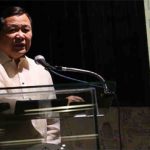The United States Army concluded that Ferdinand Marcos Sr.’s stories about “AngMaharlika,” the guerilla resistance unit he claimed to have led during the Japanese occupation, were all “fraudulent” and “absurd,” according to a New York Times article published on January 23, 1986.
According to an ABS-CBN report by CesDrilon, Ricardo Jose, director of the Third World Studies Center at the University of the Philippines, Marcos was a reservist who was trained in UP. He was called to serve in the 21st Division of the US Army Forces in the Far East (USAFFE) when World War II broke.
Jose added that Marcos served as an intelligence officer, who was tasked to monitor the location of the Japanese forces and report this to their unit heads.
As for the other functions of an intelligence officer, Jose said, “Ideally, hindi siya lumalaban.”
“Opisyal s’ya sa Bataan. Nung bumagsak yung Bataan, naging prisoner of war si Marcos. Kasama siya sa Death March,” he added.
Marcos then went on to claim that he led Maharlika to fight the Japanese forces and submitted his stories about the guerilla group to the US Army to get recognition for his deeds during the war. Among his colorful stories were about his unit burning down three Japanese war vessels in Manila in July 1944, which caused him to get injured in his right thigh.
But the US Army found out that Marcos’ stories about his Maharlika unit were fake.
However, this rejection from the Americans did not deter Marcos from his efforts to have his wartime role recognized as he continued to made appeals, seven times, according to Jose.
The ABS-CBN report also narrated how Marcos bragged that the Distinguished Service Cross he received was personally pinned on his chest by Gen. Douglas MacArthur himself.
“Kailan in-award yung Medal for Valor? 1958. Kailan nangyari yung event? 1942. At ano yung basis ng Medal for Valor na yun? Dalawang affidavits lang. Wala yung information o wala yung datos galing sa Hapon at walang supporting evidence sa US side din,” Jose said.
[ads1]
More doubts about Marcos’ medals
An article written by John Sharkey and published by The Washington Post on December 18, 1983 also made mention of this event involving MacArthur.
Sharkey wrote that there was no award for Marcos listed in the general orders of MacArthur’s command.
Moreover, Marcos’ claims about organizing a blocking force that allowed the US II Corps to withdraw to new lines, which would have turned out to be one of the biggest war exploits in Bataan, was not mentioned in MacArthur’s “Reminiscences,” or in any of the several books published about the American general.
Two high-ranking Philippine officials confirmed that MacArthur pinned a medal on Marcos when the latter paid the former’s New York City apartment a visit in 1961, with Mrs. MacArthur present.
Sharkey wrote to the general’s widow, but she replied:
“… I remember my General introducing him as Senator Marcos and mentioning that he was a guerilla during the war. I do not remember an award being given. I had either left the room or the occasion did not impress itself upon my memory.”
The author also interviewed retired Col. John R. Vance, who was a part of the decorations board chosen by Gen. Jonathan M. Wainwright, who was said to have endorsed a Medal of Honor for Marcos. But Vance said, “I never heard of that. We never saw anything about Marcos.”
[ads2]
What the US Army and Veterans’ Administration thought
Marcos continued to build himself up as a heroic guerilla leader in the Philippines. This was part of his efforts to boost his political image during his re-election campaign against Corazon C. Aquino. He used such image to show the Filipinos that he was equipped to handle the Communist insurgency, the New York Times reported.
The article was written by Jeff Gerth and was based on his and Joel Brinkley’s reporting.
Gerth further narrated that based on the documents in the US Government archives, several US Army investigations found no truth behind Marcos’ claims of heading the military operations of Maharlika against Japanese forces from 1942 to 1944.
He also said that he submitted six questions to Marcos’ office in Manila, but received no response. When calls were made to Malacañang, an aide told him that Marcos was too busy with the campaign that he was not able to look through the questions, but would respond later.
Marcos’ requests to Army officers sent between 1945 and 1948 for them to recognize Maharlika were rejected. Gerth wrote that the Army called his claims “distorted, exaggerated, fraudulent, contradictory and absurd.”
After the rejection, Marcos made another appeal, but Army captain, Elbert R. Curtis, said that after his investigation, Marcos’ claims that Maharlika covered the entire island of Luzon and that the unit served as a source of intelligent information were “fraudulent,” “preposterous,” and “a malicious criminal act.”
Another false claim? Marcos claimed that Maharlika had 474 assorted weapons and 3,825 rounds of ammunition, but the US Army document showed that the unit “possessed no arms prior to the arrival of the Americans.”
Eventually, Army investigators reached the conclusion that Maharlika was only a fictitious creation and did not exist during the war.
While promoting himself as the most decorated war hero in the Philippines, the validity of many of his 32 medals was questioned by both American and Philippine journalists. The Philippine Government defended Marcos, but said that the records validating those medals were destroyed in a fire.
The US Army recognized some of the members listed under Maharlika, but they considered the roles of Marcos and 23 other members as “of limited military value.”
The Army, however, never acknowledged that Maharlika was ever created during the Japanese creation.
Some of the former American military officers who were involved in many of the events described in Marcos’ guerilla stories were interviewed. Robert B. Lapham, who became a Marcos supporter, said that he has not heard about Maharlika’s activities against the Japanese.
Ray C. Hunt Jr. led the guerilla activities in Pangasinan, but was not aware of Maharlika. After reading Marcos’ own description of what Maharlika did during the war, he commented, “This is not true, no. Holy cow. All of this is complete fabrication. It’s a cock-and-bull story.”
In their reply to Marcos’s claims about Maharlika, the US Army cited the following reasons:
- Maharlika did not fight the Japanese forces and did not “contribute materially to the eventual defeat of the enemy.”
- There was no “definite organization” in Maharlika and “adequate records were not maintained.”
- Control was lost “because of the desertion of its commanding officer” as Marcos joined the American military unit in northern Luzon during the American invasion.
- It was impossible for Maharlika to cover such a wide area in their operations due to issues with communications, terrain and Japanese “anti-resistance activities.”
- Many of the people listed as Maharlika members lived at home to farm and perform other civilian activities, only to work of a guerilla unit part-time.
On top of that, the US Veterans’ Administration (VA), in cooperation with the Philippine Army, discovered that some of the people listed as Maharlika members actually committed “atrocities” against Filipinos and were involved in “nefarious activity,” such as selling contraband to the enemy. But no direct evidence was found to link Marcos to these activities.
One of the concerned member involved in the suspicious activities then tried to reason that they sold war materials to the enemy “to provide means of watching that enemy.”
A VA investigator concluded, “What a farce!”
Sources: (nytimes.com, youtube.com, washingpost.com)
[ads3]


